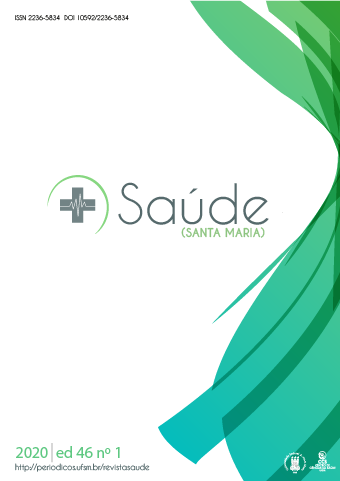Motivation for the practice of Jiu-Jitsu
DOI:
https://doi.org/10.5902/2236583439967Keywords:
Motivation, Exercise, Motor activity, Martial arts.Abstract
The aim of this research was to identify the factors that motivate Brazilian Jiu-Jitsu practitioners the most, within the following dimensions: Stress Control, Health, Sociability, Competitiveness, Pleasure and Aesthetics. We applied the Inventory of Motives for Regular Practice of Physical Activities and/or Sports (IMPRAFE–132). The sample consisted of 40 Brazilian Jiu-Jitsu practitioners, from different academies and gyms of Porto Alegre, with ages between 13 and 53 years old, of both genres. The factors that motivate the most for a regular practice of this sport can be sorted into three groups, being the first one composed by Health, the second one compose by Pleasure, followed by a group composed by Stress Control, Competitiveness, Aesthetics and Sociability, which obtained statistically inseparable values. As for Sociability, although it was within the third group, it presented a borderline value, being very close to p = 0.05. Therefore, the results indicate that the main factors that make Brazilian Jiu-Jitsu practitioners in Porto Alegre to keep a regular practice was health maintenance and seeking for pleasure moments.Downloads
References
Deci EL, Ryan RM. Self-determination theory: A macrotheory of human motivation, development, and health. Canadian Psychology/Psychologie canadienne.2008;49(3): 182–185.
Deci EL, Ryan RM. Intrisic motivation and self-determination in human behavior. New York: Plenum; 1985.
Deci EL, Ryan, RM. The “what” and “why” of goal pursuits: human needs and the self-determination of behavior. Psychological Inquiry. 2000;11(4): 227-268.
Balbinotti MA, Balbinotti C, Barbosa ML. A teoria da significação motivacional da perspectiva futura e suas aplicações no contexto do tênis infanto-juvenil. Porto Alegre: Artmed; 2009.
Guimarães SER, Boruchovitch E. O estilo motivacional do professor e a motivação intrínseca dos estudantes: uma perspectiva da Teoria da Autodeterminação. Psicologia. 2004;17(2):143-150.
Balbinotti MAA. “Inventário de Motivação a Prática Regular de Atividades Físicas e/ou Esportivas.” Laboratório de Psicologia do Esporte – Universidade Federal do Rio Grande do Sul: Porto Alegre (2004).
Wankel LM. The importance of enjoyment to adherence and psycological benefits from physic activity. Inter. J. Sport Psycology. 1993;24:151-169.
Gould D. et al. Coping strategies used by more versus less successful Olympic wrestlers. Research Quaterly for Exercise and Sport. 1992;64:83-93.
Capdevilla L, Niñerola, J, Pintanel, M. Motivación y actividad física: el autoinforme de motivos para la práctica de ejercício físico (AMPEF). Rev. Psicol. Deporte. 2004:13(1):55-74.
Cairus J. Modernization, nationalism and the elite: the genesis of brazilian Jiu-Jitsu, 1905-1920. Rev. Tempo e Argumento. 2011 jul/dez;3(2):100–121.
Gracie R. Carlos Gracie: o criador de uma dinastia. Rio de Janeiro: Record; 2008.
Gracie R, Gracie, R. Brazilian Jiu Jitsu: teoria e técnica. Rio de Janeiro: Ediouro, 2003.
Thomas J, Nelson J. métodos de pesquisa em atividades físicas. Porto Alegre: Artmed; 2002.
Barbosa MLL. Propriedades métricas do inventário de motivação à prática regular de atividade física (IMPRAF-126). 2006.
Pestana MH, Gageiro JG. Análise de dados para ciências sociais: a complementaridade do SPSS. Lisboa: Edições Silabo; 2003.
Pergher TK. Motivação à prática regular de atividades esportivas: um estudo com praticantes de basquetebol escolar (13 a 16 anos). Porto Alegre: UFRGS, 2008.
Amorim DP. Motivação à prática de musculação por adultos jovens do sexo masculino na faixa etária de 18 a 30 anos. Porto Alegre: UFRGS; 2010.
Juchem L, Balbinotti CA, Balbinotti MA, et al. A motivação para a prática regular de atividades físicas: um estudo descritivo-exploratório com tenistas do sexo masculino de 13 a 16 anos. Colec. Pesqui. Educ. Fis. Várzea Paulista, 2007, v.6, n. 2, p. 19-24.
Pacheco CH. Motivação à prática regular de atividades esportivas: um estudo com praticantes de escolinhas de futebol e futsal (13 a 17 anos). Porto Alegre: UFRGS; 2009.
Weingerg R, Gould D. Fundamentos da psicologia do esporte e do exercício. 2ª ed. Porto Alegre: Artmed; 2001.
De Rose Jr. D., Tricoli V. Basquetebol: conceitos e abordagens gerais. Barueri: Manole; 2005.
Sampedro LBR, Rocha JM, Klering RT, Saldanha RP, Balbinotti MAA, Balbinotti CAA. Motivação à prática regular de atividades físicas: um estudo com praticantes de taekwondo. Pensar a prática. 2014;17(1):19-32.
Alencar YO. As lutas no ambiente escolar: uma proposta de prática pedagógica. Rev. Bras. Ciênc. Mov. 2015;23(3):53-63.
Rufino LGB, Martins, JC. O Jiu-Jitsu brasileiro em extensão. Rev. Ciênc. Ext. 2011;7(2):84.
Rufino LGB., Darido SC. O jiu jitsu brasileiro na visão dos não praticantes. Colec. Pesqui. Educ. Fis. 2010;9(2):181–188.






